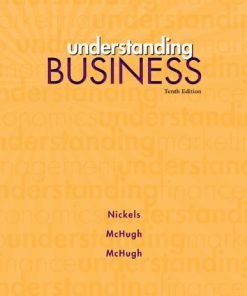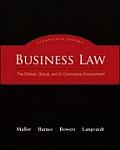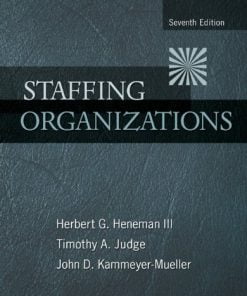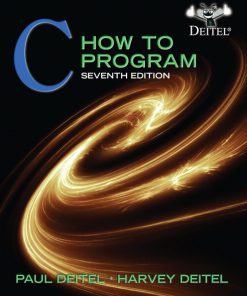Crafting and Executing Strategy The Quest for Competitive Advantage Concepts 21st Edition Thompson Solutions Manual
$35.00 Original price was: $35.00.$26.50Current price is: $26.50.
Crafting and Executing Strategy The Quest for Competitive Advantage Concepts 21st Edition Thompson Solutions Manual
This is completed downloadable of Crafting and Executing Strategy The Quest for Competitive Advantage Concepts 21st Edition Thompson Solutions Manual
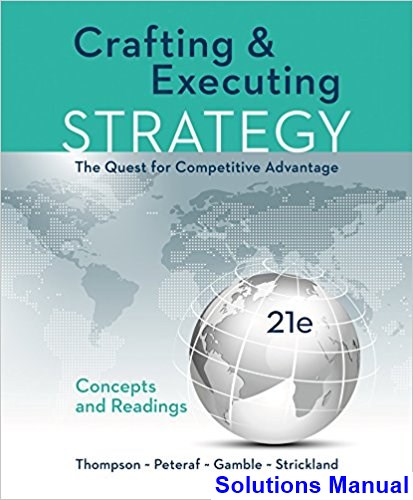
Product Details:
- ISBN-10 : 1259732789
- ISBN-13 : 978-1259732782
- Author: Thompson
Continues its tradition of being a preeminently teachable text because of its mainstream content and balanced coverage of what every student needs to know about the managerial tasks of crafting and executing strategy.
Table of Content:
part oneConcepts and Techniques for Crafting and Executing Strategy 1 Section A: Introduction and Overview 1. What Is Strategy and Why Is It Important? 2 What Is Strategy? 3 Identifying a Company?s Strategy 4 Strategy and the Quest for Competitive Advantage 5 Strategy Is Partly Proactive and Partly Reactive 8 Strategy and Ethics: Passing the Test of Moral Scrutiny 10 The Relationship between a Company?s Strategy and Its Business Model 11 What Makes a Strategy a Winner? 11 Why Are Crafting and Executing Strategy Important? 13 Good Strategy 1 Good Strategy Execution 5 Good Management 14 illustration capsules 1.1. The Chief Elements of Southwest Airlines? Strategy 5 1.2. Microsoft and Red Hat Linux: Two Contrasting Business Models 12 2. The Managerial Process of Crafting and Executing Strategy 16 What Does the Process of Crafting and Executing Strategy Entail? 17 Developing a Strategic Vision: Phase 1 of the Strategy-Making, Strategy-Executing Process 17 Linking the Vision with Company Values 21 Communicating the Strategic Vision 24 Setting Objectives: Phase 2 of the Strategy-Making, Strategy-Executing Process 26 What Kinds of Objectives to Set: The Need for a Balanced Scorecard 27 Crafting a Strategy: Phase 3 of the Strategy-Making, Strategy-Executing Process 32 The Strategy-Making Pyramid 34 Uniting the Strategy-Making Effort 37 Merging the Strategic Vision, Objectives, and Strategy into a Strategic Plan 37 Implementing and Executing the Strategy: Phase 4 of the Strategy-Making, Strategy- Executing Process 38 Initiating Corrective Adjustments: Phase 5 of the Strategy-Making, Strategy- Executing Process 39 Corporate Governance: The Role of the Board of Directors in the Strategy-Making, Strategy-Executing Process 40 illustration capsules 2.1. Exelon?s Strategic Vision 22 2.2. Examples of Strategic Visions?How Well Do They Measure Up? 23 2.3. Intel?s Two Strategic Inflection Points 26 2.4. Examples of Company Objectives 28 2.5. Organizations That Use a Balanced Scorecard Approach to Objective Setting 30 Section B: Core Concepts and Analytical Tools 3. Analyzing a Company?s External Environment 44 The Strategically Relevant Components of a Company?s External Environment 45 Thinking Strategically about a Company?s Industry and Competitive Environment 46 Question 1: What Are the Industry?s Dominant Economic Features? 48 Question 2: What Kinds of Competitive Forces Are Industry Members Facing? 50 The Rivalry among Competing Sellers 50 The Potential Entry of New Competitors 55 Competitive Pressures from the Sellers of Substitute Products 59 Competitive Pressures Stemming from Supplier Bargaining Power and Supplier?Seller Collaboration 60 Competitive Pressures Stemming from Buyer Bargaining Power and Seller?Buyer Collaboration 64 Determining Whether the Collective Strength of the Five Competitive Forces Promotes Profitability 67 Question 3: What Factors Are Driving Industry Change and What Impacts Will They Have? 68 The Concept of Driving Forces 68 Identifying an Industry?s Driving Forces 69 Assessing the Impact of the Driving Forces 74 The Link between Driving Forces and Strategy 74 Question 4: What Market Positions Do Rivals Occupy? Who Is Strongly Positioned and Who Is Not? 75 Using Strategic Group Maps to Assess the Market Positions of Key Competitors 75 What Can Be Learned from Strategic Group Maps 77 Question 5: What Strategic Moves Are Rivals Likely to Make Next? 77 Identifying Competitors? Strategies and Resource Strengths and Weaknesses 78 Predicting Competitors? Next Moves 79 Question 6: What Are the Key Factors for Future Competitive Success? 80 Question 7: Does the Outlook for the Industry Present an Attractive Opportunity? 82 illustration capsules 3.1. Comparative Market Positions of Selected Retail Chains: A Strategic Group Map Application 76 4. Analyzing a Company?s Resources and Competitive Position 86 Question 1: How Well Is the Company?s Present Strategy Working? 87 Question 2: What Are the Company?s Resource Strengths and Weaknesses and Its External Opportunities and Threats? 89 Identifying Company Resource Strengths and Competitive Capabilities 89 Identifying Company Resource Weaknesses and Competitive Deficiencies 93 Identifying a Company?s Market Opportunities 94 Identifying Threats to a Company?s Future Profitability 94 What Do the SWOT Listings Reveal? 94 Question 3: Are the Company?s Prices and Costs Competitive? 98 The Concept of a Company Value Chain 98 Why the Value Chains of Rival Companies Often Differ 100 The Value Chain System for an Entire Industry 100 Developing the Data to Measure a Company?s Cost Competitiveness 102 Benchmarking the Costs of Key Value Chain Activities 103 Strategic Options for Remedying a Cost Disadvantage 106 Translating Proficient Performance of Value Chain Activities into Competitive Advantage 106 Question 4: Is the Company Competitively Stronger or Weaker Than Key Rivals? 108 Question 5: What Strategic Issues and Problems Merit Front-Burner Managerial Attention? 111 illustration capsules 4.1. Value Chain Costs for Companies in the Business of Recording and Distributing Music CDs 103 4.2. Benchmarking and Ethical Conduct 105 Section C: Crafting a Strategy 5. The Five Generic Competitive Strategies: Which One to Employ? 114 The Five Generic Competitive Strategies 115 Low-Cost Provider Strategies 117 The Two Major Avenues for Achieving a Cost Advantage 117 The Keys to Success in Achieving Low-Cost Leadership 124 When a Low-Cost Provider Strategy Works Best 125 The Pitfalls of a Low-Cost Provider Strategy 126 Differentiation Strategies 126 Types of Differentiation Themes 127 Where along the Value Chain to Create the Differentiating Attributes 127 Achieving a Differentiation-Based Competitive Advantage 128 The Importance of Perceived Value 129 Keeping the Cost of Differentiation in Line 129 When a Differentiation Strategy Works Best 129 The Pitfalls of a Differentiation Strategy 130 Best-Cost Provider Strategies 130 The Big Risk of a Best-Cost Provider Strategy 132 Focused (or Market Niche) Strategies 132 A Focused Low-Cost Strategy 132 A Focused Differentiation Strategy 133 When a Focused Low-Cost or Focused Differentiation Strategy Is Attractive 134 The Risks of a Focused Low-Cost or Focused Differentiation Strategy 135 The Contrasting Features of the Five Generic Competitive Strategies: A Summary 135 illustration capsules 5.1. Nucor Corporation?s Low-Cost Provider Strategy 118 5.2. Utz Quality Foods? Use of Internet Technology to Reengineer Value Chain Activities 123 5.3. Toyota?s Best-Cost Producer Strategy for Its Lexus Line 131 5.4. Motel 6?s Focused Low-Cost Strategy 133 5.5. Ritz-Carlton?s Focused Differentiation Strategy OR Progressive Insurance?s Focused Differentiation Strategy in Auto Insurance? 134 6. Beyond Competitive Strategy: Other Important Strategy Choices 140 Strategic Alliances and Collaborative Partnerships 141 The Pervasive Use of Alliances 143 Why and How Strategic Alliances Are Advantageous 144 Alliances and Partnerships with Foreign Companies 145 Why Many Alliances Are Unstable or Break Apart 146 The Strategic Dangers of Relying Heavily on Alliances and Collaborative Partnerships 146 Merger and Acquisition Strategies 146 Vertical Integration Strategies: Operating across More Stages of the Industry Value Chain 150 The Strategic Advantages of Vertical Integration 150 The Strategic Disadvantages of Vertical Integration 151 Outsourcing Strategies: Narrowing the Boundaries of the Business 153 Advantages of Outsourcing 153 The Pitfalls of Outsourcing 155 Using Offensive Strategies to Secure Competitive Advantage 155 Basic Types of Offensive Strategies 156 Choosing Which Rivals to Attack 159 Choosing the Basis for Attack 159 Using Defensive Strategies to Protect the Company?s Position 160 Blocking the Avenues Open to Challengers 160 Signaling Challengers That Retaliation Is Likely 160 Strategies for Using the Internet as a Distribution Channel 161 Using the Internet Just to Disseminate Product Information 161 Using the Internet as a Minor Distribution Channel 162 Brick-and-Click Strategies: An Appealing Middle Ground 162 Strategies for Online Enterprises 163 Choosing Appropriate Functional-Area Strategies 166 First-Mover Advantages and Disadvantages 167 illustration capsules 6.1. How Clear Channel Has Used Mergers and Acquisitions to Become a Global Market Leader 149 6.2. Office Depot?s Brick-and-Click Strategy 164 6.3. The Battle in Consumer Broadband: First-Movers versus Late-Movers 169 7. Competing in Foreign Markets 172 Why Companies Expand into Foreign Markets 174 The Difference between Competing Internationally and Competing Globally 174 Cross-Country Differences in Cultural, Demographic, and Market Conditions 175 The Potential for Locational Advantages 176 The Risks of Adverse Exchange Rate Shifts 176 Host Government Policies 178 The Concepts of Multicountry Competition and Global Competition 178 Strategy Options for Entering and Competing in Foreign Markets 180 Export Strategies 180 Licensing Strategies 181 Franchising Strategies 181 A Multicountry Strategy or a Global Strategy? 182 The Quest for Competitive Advantage in Foreign Markets 185 Using Location to Build Competitive Advantage 185 Using Cross-Border Transfers of Competencies and Capabilities to Build Competitive Advantage 187 Using Cross-Border Coordination to Build Competitive Advantage 188 Profit Sanctuaries, Cross-Market Subsidization, and Global Strategic Offensives 189 Using Cross-Market Subsidization to Wage a Strategic Offensive 189 Global Strategic Offensives 191 Strategic Alliances and Joint Ventures with Foreign Partners 191 The Risks of Strategic Alliances with Foreign Partners 192 Making the Most of Strategic Alliances with Foreign Partners 193 Competing in Emerging Foreign Markets 195 Strategy Implications 196 Strategies for Local Companies in Emerging Markets 196 illustration capsules 7.1. Coca-Cola, McDonald?s, and Nestl: Users of Multicountry Strategies 184 7.2. Cross-Border Strategic Alliances 194 8. Tailoring Strategy to Fit Specific Industry and Company Situations 202 Strategies for Competing in Emerging Industries 203 Challenges When Competing in Emerging Industries 204 Strategic Avenues for Competing in an Emerging Industry 205 Strategies for Competing in Turbulent, High-Velocity Markets 206 Strategic Postures for Coping with Rapid Change 206 Strategic Moves for Fast-Changing Markets 208 Strategies for Competing in Maturing Industries 210 Industry Changes Resulting from Market Maturity 210 Strategic Moves in Maturing Industries 211 Strategic Pitfalls in Maturing Industries 212 Strategies for Firms in Stagnant or Declining Industries 213 Strategies for Competing in Fragmented Industries 214 Reasons for Supply-Side Fragmentation 214 Strategic Options for a Fragmented Industry 216 Strategies for Sustaining Rapid Company Growth 217 The Risks of Pursuing Multiple Strategy Horizons 218 Strategies for Industry Leaders 219 Strategies for Runner-Up Firms 221 Obstacles for Firms with Small Market Shares 222 Strategic Approaches for Runner-Up Companies 222 Strategies for Weak and Crisis-Ridden Businesses 224 Turnaround Strategies for Businesses in Crisis 225 Liquidation?the Strategy of Last Resort 228 End-Game Strategies 228 10 Commandments for Crafting Successful Business Strategies 229 Matching Strategy to Any Industry and Company Situation 230 illustration capsules 8.1. Yamaha?s Strategy in the Stagnant Piano Industry 215 8.2. How Microsoft Uses Its Muscle to Maintain Market Leadership 221 8.3. Lucent Technologies? Turnaround Strategy: Slow to Produce Results 227 9. Diversification: Strategies for Managing a Group of Businesses 234 When to Diversify 236 Factors That Signal It Is Time to Diversify 237 Building Shareholder Value: The Ultimate Justification for Diversifying 238 Strategies for Entering New Businesses 239 Acquisition of an Existing Business 239 Internal Start-Up 239 Joint Ventures and Strategic Partnerships 240 Choosing the Diversification Path: Related versus Unrelated Businesses 241 The Case for Diversifying into Related Businesses 241 Cross-Business Strategic Fits along the Value Chain 242 Strategic Fit, Economies of Scope, and Competitive Advantage 245 The Case for Diversifying into Unrelated Businesses 248 The Merits of an Unrelated Diversification Strategy 249 The Drawbacks of Unrelated Diversification 252 Combination Related?Unrelated Diversification Strategies 253 Evaluating the Strategy of a Diversified Company 254 Step 1: Evaluating Industry Attractiveness 255 Step 2: Evaluating Business-Unit Competitive Strength 258 Step 3: Checking the Competitive Advantage Potential of Cross-Business Strategic Fits 262 Step 4: Checking for Resource Fit 263 Step 5: Ranking the Business Units on the Basis of Performance and Priority for Resource Allocation 266 Step 6: Crafting New Strategic Moves to Improve Overall Corporate Performance 267 After a Company Diversifies: The Four Main Strategy Alternatives 269 Strategies to Broaden a Diversified Company?s Business Base 270 Divestiture Strategies Aimed at Retrenching to a Narrower Diversification Base 271 Strategies to Restructure a Company?s Business Lineup 273 Multinational Diversification Strategies 275 illustration capsules 9.1. Five Companies That Have Diversified into Related Businesses 246 9.2. Five Companies That Have Diversified into Unrelated Businesses 250 9.3. Managing Diversification at Johnson & Johnson 271 9.4. The Global Scope of Four Prominent Diversified Multinational Corporations 276 10. Strategy, Ethics, and Social Responsibility 282 Strategy and Ethics 283 What Do We Mean by Business Ethics? 283 The Three Categories of Management Morality 284 What Are the Drivers of Unethical Strategies and Business Behavior? 285 Business Ethics in the Global Community 289 Approaches to Managing a Company?s Ethical Conduct 295 Why Should Company Strategies Be Ethical? 298 Linking a Company?s Strategies to Its Ethical Principles and Core Values 299 Strategy and Social Responsibility 301 What Do We Mean by Social Responsibility? 302 Linking Strategy and Social Responsibility 304 The Moral Case for Corporate Social Responsibility 305 The Business Case for Socially Responsible Behavior 306 The Controversy over Do-Good Executives 308 How Much Attention to Social Responsibility Is Enough? 310 Linking Social Performance Targets to Executive Compensation 310 illustration capsules 10.1. When Cultures Clash on Ethical Standards: Some Examples 291 10.2. Strategies to Gain New Business at Wall Street Investment Banking Firms: Ethical or Unethical? 300 Section D: Executing the Strategy 11. Building Resource Strengths and Organizational Capabilities 316 A Framework for Executing Strategy 318 The Principal Managerial Components of the Strategy Execution Process 319 Building a Capable Organization 321 Staffing the Organization 322 Putting Together a Strong Management Team 322 Recruiting and Retaining Capable Employees 322 Building Core Competencies and Competitive Capabilities 324 The Three-Stage Process of Developing and Strengthening Competencies and Capabilities 325 From Competencies and Capabilities to Competitive Advantage 327 The Strategic Role of Employee Training 328 Matching Organization Structure to Strategy 328 Deciding Which Value Chain Activities to Perform Internally and Which to Outsource 328 Making Strategy-Critical Activities the Main Building Blocks of the Organization Structure 331 Determining the Degree of Authority and Independence to Give Each Unit and Each Employee 334 Providing for Internal Cross-Unit Coordination 337 Providing for Collaboration with Outside Suppliers and Strategic Allies 338 Perspectives on Structuring the Work Effort 339 Organizational Structures of the Future 340 illustration capsules 11.1. How General Electric Develops a Talented and Deep Management Team 323 11.2. Cross-Unit Coordination on Technology at 3M Corporation 339 12. Managing Internal Operations: Actions That Promote Better Strategy Execution 344 Marshaling Resources Behind the Drive for Good Strategy Execution 345 Instituting Policies and Procedures That Facilitate Strategy Execution 346 Adopting Best Practices and Striving for Continuous Improvement 349 How the Process of Identifying and Incorporating Best Practices Works 349 TQM and Six Sigma Quality Programs: Tools for Promoting Operational Excellence 351 Capturing the Benefits of Best-Practice and Continuous Improvement Programs 354 Installing Information and Operating Systems 356 Instituting Adequate Information Systems, Performance Tracking, and Controls 357 Exercising Adequate Controls over Empowered Employees 358 Tying Rewards and Incentives to Strategy Execution 359 Strategy-Facilitating Motivational Practices 359 Striking the Right Balance between Rewards and Punishment 362 Linking the Reward System to Strategically Relevant Performance Outcomes 362 illustration capsules 12.1. Graniterock?s ?Short Pay? Policy: An Innovative Way to Promote Strategy Execution 348 12.2. Whirlpool?s Use of Six Sigma to Promote Operating Excellence 353 12.3. Companies with Effective Motivation and Reward Techniques 361 12.4. Nucor and Bank One: Two Companies That Tie Incentives Directly to Strategy Execution 363 13. Corporate Culture and Leadership: Keys to Good Strategy Execution 368 Building a Corporate Culture That Promotes Good Strategy Execution 369 What to Look for in Identifying a Company?s Corporate Culture 370 Culture: Ally or Obstacle to Strategy Execution? 373 Strong versus Weak Cultures 375 Unhealthy Cultures 376 Adaptive Cultures 378 Creating a Strong Fit between Strategy and Culture 379 Grounding the Culture in Core Values and Ethics 383 Establishing a Strategy?Culture Fit in Multinational and Global Companies 390 Leading the Strategy Execution Process 391 Staying on Top of How Well Things Are Going 391 Putting Constructive Pressure on the Organization to Achieve Good Results 392 Keeping the Internal Organization Focused on Operating Excellence 394 Leading the Development of Better Competencies and Capabilities 395 Displaying Ethical Integrity and Leading Social Responsibility Initiatives 395 Leading the Process of Making Corrective Adjustments 397 illustration capsules 13.1. The Culture at Alberto-Culver 370 13.2. The Culture-Change Effort at Alberto-Culver?s North American Division 384 13.3. Lockheed Martin?s Corrective Actions after Violating U.S. Antibribery Laws 396 part twoCases in Crafting and Executing Strategy C-1 Section A: Crafting Strategy in Single-Business Companies 1. Starbucks in 2004: Driving for Global Dominance C-2 Arthur A. Thompson, The University of Alabama Amit J. Shah, Frostburg State University Thomas F. Hawk, Frostburg State University 2. Netflix C-33 Braxton Maddox, The University of Alabama 3. Azalea Seafood Gumbo Shoppe in 2004 C-42 John E. Gamble, University of South Alabama 4. Non Stop Yacht, S.L. C-58 Charlene Nicholls-Nixon, The University of Western Ontario 5. Competition in the Bottled Water Industry C-70 John E. Gamble, University of South Alabama 6. Dollar General and the Extreme Value Retailing Industry C-86 Sue A. Cullers, Tarleton State University S. Stephen Vitucci, Tarleton State University?Central Texas 7. Growth Strategy and Slotting at No Pudge! Foods, Inc. C-102 Chris Robertson, Northeastern University 8. Dell Computer in 2003: Driving for Industry Leadership C-109 Arthur A. Thompson, The University of Alabama John E. Gamble, University of South Alabama 9. Electronic Arts and the Global Video Game Industry C-140 Arthur A. Thompson, The University of Alabama 10. Nexity and the U.S. Banking Industry C-163 John Frank Yother, The University of Alabama 11. Making It Big C-185 Joan Winn, University of Denver 12. Outback Steakhouse C-197 Sarah June Gauntlett, University of Alabama 13. McDonald?s: Polishing the Golden Arches C-213 Lou Marino, The University of Alabama Katy Beth Jackson, The University of Alabama 14. Maple Leaf Consumer Foods?Fixing Hot Dogs C-235 Allen Morrison, The University of Western Ontario 15. Krispy Kreme Doughnuts, Inc. C-245 Arthur A. Thompson, The University of Alabama Amit J. Shah, Frostburg State University 16. Andrea Jung and Avon Products in 2003: Accelerating the Transformation C-267 John E. Gamble, University of South Alabama 17. eBay: In a League by Itself C-292 Louis Marino, The University of Alabama Patrick Kreisler, The University of Alabama 18. Note on the Security Management and Manufacturers Industry C-318 Marilyn L. Taylor, University of Missouri?Kansas City Theresa A. Coates, Rensselaer Polytechnic Institute 19. Pivot International?Pursuing Growth C-343 Marilyn L. Taylor, University of Missouri?Kansas City Theresa A. Coates, Rensselaer Polytechnic Institute 20. Bayer AG: Children?s ASPIRIN C-360 Lauranne Buchanan, Thunderbird?The American Graduate School of International Management Christopher K. Merker, Thunderbird?The American Graduate School of International Management 21. Harley-Davidson C-376 John E. Gamble, University of South Alabama Roger Schfer, University of South Alabama 22. Hero Honda Motors (India) Ltd.: Is It Honda That Made It a Hero? C- 396 Kannan Ramaswamy, Thunderbird?The American Graduate School of International Management Rahul Sanchez, Thunderbird?The American Graduate School of International Management 23. Puma AG C-411 Lutz Kaufmann, The WHU Otto Beisheim Graduate School of Management 24. The Globalization of Beringer Blass Wine Estates C-433 Armand Gilinsky, Jr., Sonoma State University Raymond H. Lopez, Pace University Richard Castaldi, San Francisco State University Section B: Crafting Strategy in Diversified Companies 25. Land O?Lakes, Inc. C-461 Michael A. Boland, Kansas State University Vincent Amanor-Boadu, Kansas State University David Barton, Kansas State University 26. Unilever?s Path to Growth Strategy: Is It Working? C-479 Arthur A. Thompson, The University of Alabama 27. LVMH?s Diversification Strategy into Luxury Goods C-509 John E. Gamble, University of South Alabama Section C: Implementing and Executing Strategy 28. Robin Hood C-532 Joseph Lampel, New York University 29. Procter & Gamble: Organization 2005 and Beyond C-534 Ravi Madapati, ICFAI Knowledge Center 30. The Global Leadership of Carlos Ghosn at Nissan C-546 John P. Millikin, Thunderbird?The American Graduate School of International Management Dean Fu, Thunderbird?The American Graduate School of International Management 31. Wal-Mart Stores, Inc.: A New Set of Challenges C-557 Arthur A. Thompson, The University of Alabama 32. Kmart: Striving for a Comeback C-583 John E. Gamble, University of South Alabama 33. The Portman Ritz-Carlton: Asia?s Best Employer C-603 Matthew Chang, International Institute for Management Development Ellie Weldon, International Institute for Management Development 34. Continental Airlines in 2003: Sustaining the Turnaround C-611 Arthur A. Thompson, The University of Alabama 35. Southwest Airlines: Culture, Values, and Operating Practices C-636 Arthur A. Thompson, The University of Alabama John E. Gamble, The University of South Alabama Section D: Strategy, Ethics, and Social Responsibility 36. Benziger Family Winery C-665 Murray Silverman, San Francisco State University Tom Lanphar, California Department of Toxic Substances Control 37. Andy Decker and the Ethics of Downloading Music from the Internet C-680 Janet Rovenpor, Manhattan College indexes Organization I-1 Name I-13 Subject I-19 endnotes
People Also Search:
crafting and executing strategy the quest for competitive advantage concepts
crafting and executing strategy the quest for competitive advantage concepts 21st
crafting and executing strategy the quest for competitive advantage concepts 21st edition
crafting and executing strategy the quest for competitive advantage concepts download scribd
crafting and executing strategy the quest for competitive advantage concepts 21st edition solution manual download
Related products
Solution Manual
Understanding Business Nickels 10th Edition Solutions Manual
Solution Manual
International Accounting Doupnik 4th Edition Solutions Manual
Solution Manual
Solution Manual
Solution Manual
Solution Manual for Absolute C++, 5/E 5th Edition Walter Savitch





